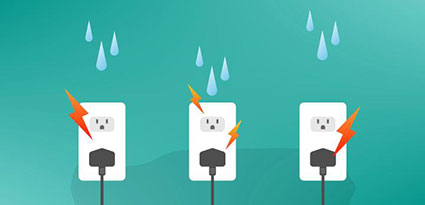Worried about what to do when the inevitable happens and you knock your glass of water onto the electrical board?
This is a severe health hazard to you and your family and the outlets must be dried, repaired, or replaced immediately.
This article will break down 3 ways to deal with wet outlets and give you tips on how you can minimise the risks when dealing with this dangerous situation. Including tips to help prevent damage to yourself, others, and your home.
However, we highly recommend that you call in a team of professional electricians to assist you.
What Happens When Water Gets Into an Electrical Outlet?
Since childhood, we have been told by our parents, teachers and other adults that water plus electricity could mean serious injury and even death.
Electrical currents are always travelling via the shortest path possible that could lead it back to the ground. This path can be made of anything that can conduct electricity like wires, for example.
Water is one of the most excellent and efficient conductors of electricity. This means that an electric current can pass through water on its way to the ground. If you happen to be touching water that in turn is touching electricity, the current WILL pass through your body as well giving you an electric shock.
This is also one of the reasons why pool, spa, and sauna wiring are different from standard electrical wiring.
Touching a Wet Outlet
You will receive an electric shock if you touch a wet electrical outlet in your home.
An electric shock can cause pain, a significant feeling of numbness as well as leave a burn on your skin where the current entered and left your body. It can cause internal damage to blood vessels, nerves and muscle tissue, and worst of all, lead to a fatal cardiac arrest or other injuries.
Take Note: Some damage from electrical shocks are not even visible until 10-14 days later.
Using a Wet Outlet
If by chance, you plug an appliance into a wet outlet, it may cause a short circuit.
Short circuits can damage your appliances, cause electrical shocks, and worse, an electrical fire.
Electrical fires start in and spread through the electric wiring system of your home. This includes all cables, circuit breakers, and other electrical components.
You will need to call emergency electricians to come right away to fix the wet outlets and handle any short circuits and overloads before more damage is done.
What Can Cause Water To Enter Your Electrical Outlets?
The following situations can easily allow water to get into our outlets.
- Leaking Roof
- Flooding
- Burst Pipes
- Open or Damaged windows
- Bathroom / Kitchen – Accidental splashing of water near a sink
But in addition to these, simply knocking over a cup or bucket of water could put you into a dangerous situation if there are electricals around. Knowing what to do when an outlet is wet is essential to minimising damage and physical harm.
What to Do When an Electrical Outlet Gets Wet
1. Shut Down the GFCI Outlet
The GFCI (Ground Fault Circuit Interrupter) outlet is a special outlet that automatically shuts down if it detects a disruption in the flow of electricity. Even a small amount of humidity in your kitchen or bathroom outlets can supposedly turn the GFCI off.
However, there are times, though, when the wet GFCI outlet stays on, and you will have to shut it down manually. This is quickly done by pressing the reset and test buttons – found directly on the outlet itself – at the same time.
To make sure that it is off and no more current is passing through it, test the outlet using a voltage metre. Check the outlet up close as well and if you see even more water than expected inside, call an emergency electrician to handle the cleanup and repairs for you.
2. Turn Off Your Breaker Box
Whether you only have one or several wet outlets in your home, and your GFCI rated outlets have been shut down manually, it’s still safer to err on the side of caution and turn off your breaker box immediately.
If your breakers are correctly labelled, look for the correct one and shut it down to stop the electricity from flowing into the wet outlet.
If your breakers are not labelled, you’ll have to turn each one on and off until you find the correct switch for that particular outlet.
If you have several water-logged outlets spread throughout your home, turn the power off at the main breaker to ensure the safety of your home and family.
If you are still not sure that you shut down the correct breaker, do not attempt to dry the outlets on your own. Get in touch with a professional emergency electrician to do the job for you.
3. Dry the Wet Electrical Outlets
Once you have shut down GFCI outlets and ensured that there is no more live electricity running into the affected outlets by shutting down the breaker box, you can now move on to the last step which is drying the wet electrical outlets.
At this point, despite all the precautions mentioned above, we would again like to remind you not to touch an outlet that is still wet inside. Even if there is no more current, you might still get an unpleasant shock.
It is best to wait for the outlet to dry naturally. If the water damage is not too bad, a period of 10-12 hours might be sufficient drying time. You can also position air blowers, or hair dryers (blasting cold air preferably) to let it dry out faster.
If you find that there is just too much water inside the outlet and it is taking too long to dry, we suggest you call a professional electrician.
Most electricians advise that replacing a water-damaged outlet is safer than drying them, especially for outlets left wet longer and exposed to a more substantial amount of water.
Seeking Professional Help
A wet electrical outlet can destroy your home as well as potentially hurt you and your family members physically. Taking immediate action will help reduce the damage, and if you feel like this is over your head, don’t hesitate on calling experienced emergency electricians to help repair or replace your outlets.



